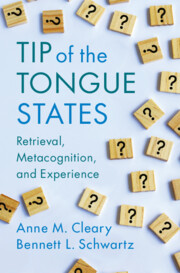Refine search
Actions for selected content:
149 results
Chapter 2 - The Moral Purpose of Wisdom
-
-
- Book:
- Purpose In Life As Ancient but Nascent
- Published online:
- 31 October 2025
- Print publication:
- 20 November 2025, pp 13-44
-
- Chapter
- Export citation
Curiosity and Mental Search
-
- Journal:
- Episteme , First View
- Published online by Cambridge University Press:
- 07 November 2025, pp. 1-18
-
- Article
-
- You have access
- Open access
- HTML
- Export citation
The shadow of trauma: impaired mentalization in clinical populations – a systematic review
-
- Journal:
- Psychological Medicine / Volume 55 / 2025
- Published online by Cambridge University Press:
- 08 July 2025, e186
-
- Article
-
- You have access
- Open access
- HTML
- Export citation
Chapter 1 - Introduction and History of Research on Tip-of-the-Tongue States
-
- Book:
- Tip of the Tongue States
- Published online:
- 26 May 2025
- Print publication:
- 12 June 2025, pp 1-18
-
- Chapter
- Export citation
Chapter 5 - Phenomenology
-
- Book:
- Tip of the Tongue States
- Published online:
- 26 May 2025
- Print publication:
- 12 June 2025, pp 91-109
-
- Chapter
- Export citation

Tip of the Tongue States
- Retrieval, Metacognition, and Experience
-
- Published online:
- 26 May 2025
- Print publication:
- 12 June 2025
Research agenda: From monolingual to multilingual norms in multilingual classrooms
-
- Journal:
- Language Teaching , First View
- Published online by Cambridge University Press:
- 20 March 2025, pp. 1-16
-
- Article
-
- You have access
- Open access
- HTML
- Export citation
Self-regulated learning strategies in L1 and L2 reading
-
- Journal:
- Bilingualism: Language and Cognition / Volume 28 / Issue 4 / August 2025
- Published online by Cambridge University Press:
- 20 December 2024, pp. 879-896
-
- Article
-
- You have access
- Open access
- HTML
- Export citation
Time-Based prospective memory predicts insight into functional abilities among community-dwelling older adults
-
- Journal:
- Journal of the International Neuropsychological Society / Volume 31 / Issue 1 / January 2025
- Published online by Cambridge University Press:
- 03 December 2024, pp. 11-21
-
- Article
- Export citation
An action research project to evaluate a simple dictionary usage tool with year 7 students of Latin
-
- Journal:
- Journal of Classics Teaching / Volume 26 / Issue 51 / Spring 2025
- Published online by Cambridge University Press:
- 22 October 2024, pp. 64-70
-
- Article
-
- You have access
- Open access
- HTML
- Export citation
Relationship between subjective cognitive functioning and fluid and crystallized cognitive abilities in bipolar disorder
-
- Journal:
- Journal of the International Neuropsychological Society / Volume 30 / Issue 8 / October 2024
- Published online by Cambridge University Press:
- 16 October 2024, pp. 719-727
-
- Article
-
- You have access
- Open access
- HTML
- Export citation
11 - Psychological Individual Differences
-
- Book:
- A Practical Guide to Second Language Teaching and Learning
- Published online:
- 03 May 2024
- Print publication:
- 30 May 2024, pp 239-257
-
- Chapter
- Export citation
Are you how you eat? Aspects of self-awareness in eating disorders
-
- Journal:
- Personality Neuroscience / Volume 7 / 2024
- Published online by Cambridge University Press:
- 21 May 2024, e9
-
- Article
-
- You have access
- Open access
- HTML
- Export citation
Exploring metacognitive processes in design ideation with text-to-image AI tools
-
- Journal:
- Proceedings of the Design Society / Volume 4 / May 2024
- Published online by Cambridge University Press:
- 16 May 2024, pp. 915-924
-
- Article
-
- You have access
- Open access
- Export citation
Do metacognitive therapies for schizophrenia-spectrum disorders work? A meta-analytic investigation
-
- Journal:
- Psychological Medicine / Volume 54 / Issue 8 / June 2024
- Published online by Cambridge University Press:
- 21 March 2024, pp. 1510-1518
-
- Article
-
- You have access
- Open access
- HTML
- Export citation
3 - Theoretical Perspectives on Success
- from Part I
-
- Book:
- Succeeding and Adult Dyslexia
- Published online:
- 11 January 2024
- Print publication:
- 01 February 2024, pp 59-86
-
- Chapter
- Export citation
Metamemory and executive function mediate the age-related decline in memory
-
- Journal:
- Journal of the International Neuropsychological Society / Volume 30 / Issue 5 / June 2024
- Published online by Cambridge University Press:
- 15 January 2024, pp. 479-488
-
- Article
-
- You have access
- Open access
- HTML
- Export citation
7 Domain-Specific Assessments for Metacognition in Older Adults Sustaining Traumatic Brain Injury
-
- Journal:
- Journal of the International Neuropsychological Society / Volume 29 / Issue s1 / November 2023
- Published online by Cambridge University Press:
- 21 December 2023, pp. 119-120
-
- Article
-
- You have access
- Export citation
35 Happiness Project: A Customized Mind Body Intervention Significantly Changed the Social Relationship Scores Among Healthy College Students during the COVID-19 pandemic
-
- Journal:
- Journal of the International Neuropsychological Society / Volume 29 / Issue s1 / November 2023
- Published online by Cambridge University Press:
- 21 December 2023, p. 824
-
- Article
-
- You have access
- Export citation
21 Patterns of Neural Activation Associated with Judgments of Learning and Retrospective Confidence Judgments in Individuals with TBI
-
- Journal:
- Journal of the International Neuropsychological Society / Volume 29 / Issue s1 / November 2023
- Published online by Cambridge University Press:
- 21 December 2023, pp. 130-131
-
- Article
-
- You have access
- Export citation
